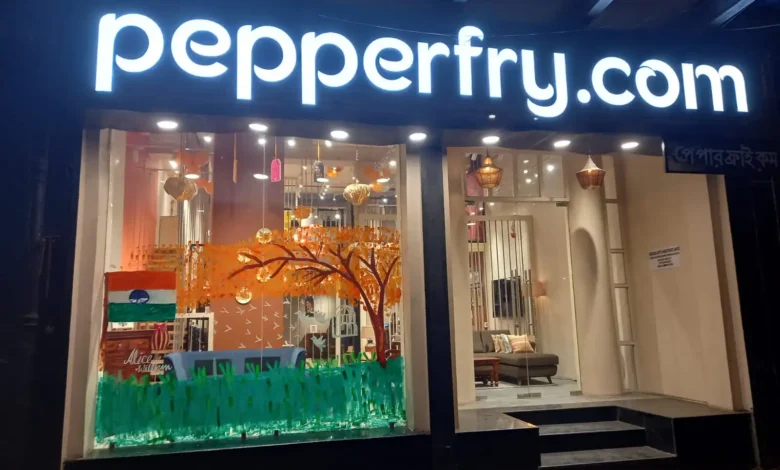Pepperfry: Once Planning For IPO, Now Selling Due To Losses Shows How Hollow & Distorted Indian Startups Are.

Pepperfry, the 12-year-old omnichannel furniture retail startup backed by Norwest Venture Partners, has engaged Ambit to explore potential buyers. With flatlining sales and persistent losses, the company is now seeking a strategic exit. Sources close to the developments have revealed that Pepperfry is looking for either a potential buyer or a strategic acquisition by a larger player if the deal terms are favorable.
This move comes after several years of stagnation and failed attempts to go public through an initial public offering (IPO).
According to insiders, Pepperfry’s revenue growth has stagnated over the past four years, and its losses have remained consistent. “The company’s revenue has stagnated, and its losses have not reduced over the past four years or so, forcing investors to look for an alternative route and find a strategic buyer for an exit,” one source explained. Despite ongoing discussions, the company has yet to finalize a buyer.
The recent demise of co-founder and former CEO Ambareesh Murty in August 2023 further compounded the company’s challenges. Murty, who had been a significant driving force behind Pepperfry’s growth, had helped the company scale up over the years. His loss has left a leadership vacuum, making the path forward more uncertain.
Pepperfry’s difficulties are heightened by a highly competitive market. The company competes with established players such as Reliance-owned Urban Ladder, IKEA, Wakefit, and Wooden Street. Despite a growing market for furniture retail, profitability has remained elusive for many in the industry.
This environment has made it challenging for Pepperfry to achieve the exponential growth expected by venture capitalists. In the fiscal year 2019 (FY19), Pepperfry reported revenue of ₹207 crore, which grew modestly to ₹290 crore by the end of FY23, according to data from Tracxn, a private markets data provider. Although this represents a compound annual growth rate (CAGR) of around 10% over four years, it falls short of the exponential growth that investors typically seek, particularly in loss-making startups.
Throughout this period, Pepperfry’s annual losses have remained steady at around ₹180-190 crore. The company’s financial performance has not kept pace with investor expectations, leading to an increasingly pressing need for an exit strategy. As many startups in the market are slashing costs to extend their operational runway amid a challenging funding environment, Pepperfry has struggled to reduce its losses.
The company has not yet filed its financial results for FY24, which would provide a clearer picture of its recent performance.
Pepperfry’s current valuation and acquisition talks add another layer of complexity. Previously valued at around $330 million, the company has sought a valuation of approximately $200-220 million in recent negotiations with potential buyers. However, this figure has been met with skepticism.
As one person involved in the discussions noted, “Pepperfry, which is a marketplace, wanted a multiple on their gross merchandise value (GMV), which was around ₹900-1,000 crore. Its revenue, however, is in the ₹270-300 crore range. So, Pepperfry asking for a valuation of around ₹1,600-1,800 crore ($200-220 million) made no sense to any of us.”
As Pepperfry explores potential buyers, several names have surfaced. Paint companies such as Nerolac, Berger Paints, Birla Opus, and Asian Paints, which are looking to diversify their revenue streams, are seen as likely candidates. These companies are expanding into home services and could find strategic value in acquiring a furniture marketplace like Pepperfry. Similarly, a larger competitor like Livspace could consider acquiring Pepperfry to strengthen its market position.
Other potential suitors include B2B companies such as Infra.Market, which has built a portfolio of brands including home makeover solutions firm IVAS Homes. Cement companies like RDC and paint companies like Shalimar Paints may also see Pepperfry as an opportunity to expand into the multi-category product market.
Despite these possibilities, no final decision has been made, and Pepperfry and Ambit have not responded to queries regarding the ongoing sale discussions. As the company navigates its financial and strategic challenges, finding the right buyer or partner will be crucial to shaping Pepperfry’s future in the competitive furniture retail market.
Last 5 Years Losses In Pepperfry
Pepperfry has experienced consistent financial losses over the past five years, reflecting the challenges of scaling an online furniture retail business in a competitive market. Here is an overview of Pepperfry’s estimated annual losses over the last five years:
- FY19: The company reported losses of approximately ₹181 crore.
- FY20: Losses remained high, with reports indicating a loss of around ₹186 crore.
- FY21: The pandemic year saw many businesses struggle, and Pepperfry was no exception. The losses were estimated at around ₹183 crore.
- FY22: Pepperfry continued to face financial challenges, recording losses in the range of ₹180-190 crore.
- FY23: Losses remained relatively stable, still hovering around ₹180-190 crore, as the company struggled to turn profitable.
These figures suggest that despite attempts to scale and streamline operations, Pepperfry has not yet been able to reduce its annual losses significantly. The company has maintained a loss-making streak, mainly due to high operational costs, marketing expenses, and competitive pressures.
Last 5 Year Fundings In Pepperfry
Pepperfry has raised several rounds of funding over the last five years to sustain its operations, scale its business, and attempt to reach profitability. Here’s an overview of the key funding rounds for Pepperfry during this period:
- 2018:
- Series F: In 2018, Pepperfry raised approximately $31 million in a Series F round led by State Street Global Advisors and Norwest Venture Partners. This funding was aimed at expanding its footprint in the Indian market, enhancing its technology platform, and boosting marketing efforts.
- 2019:
- Debt Financing: Pepperfry secured debt financing of about ₹35 crore (approximately $5 million) from InnoVen Capital. This round was aimed at improving its supply chain and expanding its logistics network to increase efficiency.
- 2020:
- Debt Funding: In the midst of the pandemic, Pepperfry raised an additional ₹35 crore (around $5 million) in debt from InnoVen Capital. The company utilized this funding to sustain its operations during the challenging period and to enhance its technology for better customer experience.
- 2021:
- Pre-IPO Funding: As part of its preparation for an initial public offering (IPO), Pepperfry raised around $40 million in a pre-IPO funding round. This funding was aimed at strengthening the company’s balance sheet and helping it move towards profitability.
- 2022:
- Series G: Pepperfry secured another round of funding worth approximately $23 million led by existing investors like Norwest Venture Partners. The funding was primarily aimed at supporting the company’s expansion plans, including launching new categories and scaling its omnichannel presence.
Despite these funding rounds, which have helped Pepperfry in maintaining operations and growing its market presence, the company has struggled with profitability, leading it to explore strategic alternatives, including the recent attempt to find a buyer.




